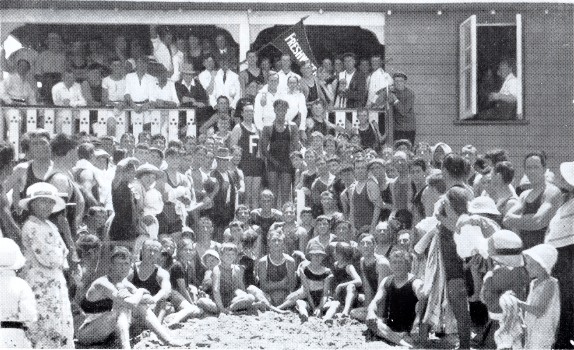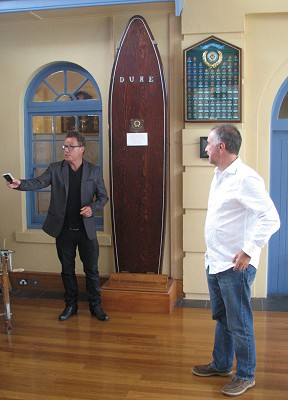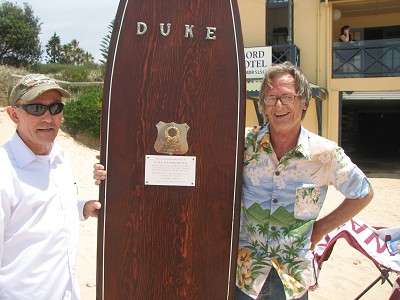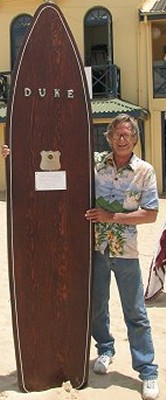surfresearch.com.au
 |
surfresearch.com.au
the catalogue
#100
|
| 1914 Duke Kahanamoku's
Alaia 8 ft 6.5" |
#100
|

MANUFACTURE
MANUFACTURER:
Hudson's Timber Yard, Blackwattle Bay, Glebe, Sydney (?).
SHAPER:
Duke Kahanamoku
DESIGN:
Alaia/Gothic/Church Window
DESIGNER: Duke
Kahanamoku
SPECIFICATIONS
CONSTRUCTION
One piece
imported solid 100 year old Sugar pine (Pinus lambertiana)
timber blank supplied and prepared (tempate cut out) by Hudson's
Timber Yard, [Blackwattle Bay, Glebe], Sydney.
(Hudson's may have had a yard on the north side?).
Hand shaped by
Duke Kahanamoku (possibly) at Freshwater Beach, December 1914.
DIMENSIONS
|
Length :
|
8
|
ft |
6 1/2
|
inches |
|
|
|
Width :
|
23
|
inches |
|
Wide Point :
|
+ve 6
|
inches |
|
Nose :
|
14.5
|
inches |
|
Tail :
|
19 .5
|
inches |
|
Thickness :
|
2 .75
|
inches |
|
Pod :
|
14
|
inches |
|
Nose Lift :
|
|
inches |
|
Tail Lift :
|
|
inches |
|
Weight :
|
78
|
pounds |
35 kilos
|
Volume :
|
|
litres |
|
Other :
|
|
inches |
|
|
|
|
FEATURES
Nose:
round
Tail:
square
Deck:
flat
Bottom: very
slightly
rolled,the often reported "slight concave" in the bottom is not evident.
Rails:
rounded square
Rocker:
slight nose lift
FIN:
none [standard for the period].
DECOR
DECAL:
COLOUR:
Natural
pine timber, (oiled)
MARKINGS:
The
board was originally plain timber, but over the years
has several elements added to it.
Circa
1953, it had four metal letters (DUKE) affixed with
screws to the board and painted white pin-lines.
Sometime
after 1956, a bronze plate with Claude West's 1917
Bronze Medallion was added, as well as a engraved
chrome plate reading:
This surfboard was made by
DUKE
KAHANAMOKU
who
introduced surfboard riding
to
Australia for the first time at
Freshwater
Beach
Feb. 1915.
Presented
to
Freswater SLSC
October
11th 1953 by
Claude
West
1st
surfboard champion
Previously
exhibited in the Club Room of the Freshwater Surf
Lifesaving Club, in 2012 it was refurbished and
relocated to the club's Heritage Room.
The
current display also includes three lateral bolts,
that were inside the board.
|

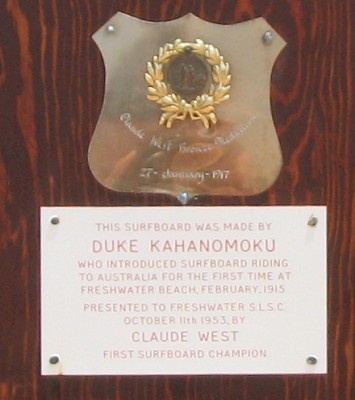
|
The
Bolts
Three
lateral bolts, that were inside the board are now
displayed at the foot of the board in a timber case. |
|
NOTES
BOARD HISTORY
Invited to tour Australia as the 1912
Olympic swimming champion, Duke
Kahanamoku was expected to demonstrate surfboard
riding, particularly when in Sydney where there was a
growing enthusiasm for the sport.
Swimming officials promoted their carnivals with dramatic coloured
posters showing him surfriding.
For a
detailed account of the tour, see History :
Duke Kahanamoku
Upon arrival, journalist and fellow Olympic competitor,
Cecil Healey raised the prospect of a
surfboard riding demonstration, specifically
enquiring:
"Did you bring your surf board
with you?", to which he replied:
"Why no, we were told the use of
boards was not permitted in Australia."
Evidently
noticing the look of keen disappointment on my
face, he quickly added: "But
I can easily make one here."
- Cecil Healey: The
Duke
Reaches Sydney,
The Referee, 16 December 1914, page 1.
This "prohibition of surfboards" was possibly
communicated by Alexander Hume Ford, the founder
of the Outrigger Canoe Club at Waikiki, who
visited Manly in
1908 and apparently was given this impression:
I wanted to try riding the
waves on a surf-board, but it was forbidden.
-
Alexander Hume Ford: Beach
Culture in Sydney, Australia.
The
Red Funnel, Dunedin, New Zealand.Volume VI,
Number 5, June 1908, page 469.
|

Thoms: Surfmovies
(2000) page 22. |
Although often
reported, there never was an outright ban on using
surfboards in Sydney, however there were government
regulations restricting their use when considered dangerous
to surf bathers, see Before
Duke 1900 - 1914.
While most of the boards causing distress were small prone
boards ridden among crowds of surf-bathers, there were probably
about ten large boards, that is designed to be ridden standing,
on Sydneys' beaches.
In early
1914, Harald Baker noted:
Surf
boards, both long and
short (have) been almost a practice at
Manly for some years past,
...
and there
are several of these in use at both Coogee and at Maroubra.
- Harald Baker: Surfing, Evening
News, Sydney, Saturday 11 April 1914,
page 10.
The enthusiasm of the
Australian surfriders saw arrangements for Duke to be
accommodated at Boomerang Camp at Freshwater Beach.
His hosts were Freshwater club and Surf
Bathing Association officials, Roy Doyle and Don Mclntyre.
As secretary of the Freshwater SLSC and Hon.
Secretary of the Surf Bathing Association, McIntrye played an
important role in the organising of the exhibitions.
- C.B.Maxwell: Surf (1949), page 237.
Plans were also made for the construction of a
surfboard.
In the, probably "polished," introduction to the
second impression of Jack Pollard's The Surfriders, Duke
Kahanamoku recalled:
A few Australian surfers
had tried the boards but they hadn't got the knack, so I
pencilled out
a design and asked George Hudson's
timber yard to make up a board for me.
I finished off the board by hand myself and
at Freshwater Beach on Sydney's northside,
showed Australians for the first time how it
was done.
Earlier,
Reg Harris reported that the billet for the board was sugar pine
(Pinus lambertiana), over-estimated its length, and
confirmed that the hand-shaping was completed by Duke:
A timber firm, George Hudson’s, donated a
piece of sugar pine 9 ft long, 2 ft wide and 3" thick.
The firm did
the rough cutting to Duke’s instructions then he finished
off the finer designing of the
bottom of the board, to give it lift on a wave.
- Harris: Manly
SLSC (1961) page 54.
Note that
Harris' "the finer designing of the bottom of the
board" has been often interpreted incorrectly to indicate
that the bottom had a concave section.
Although
Hudson's apparently had several yards in Sydney, their
principle timber yard was in Blackwattle Bay, Glebe, and it is
the likely source of the billet, which could have been cut
sometime before the 20th December.
W.
F. Corbett also reported at the time that the board was
sugar pine, but noted that this was a substitute for
redwood, the prefered timber used for surfboards in
Hawai'i at this time:
The board used by Kahanamoku weighed 78lb,
and was sugar pine.
He would have preferred redwood, but a properly seasoned
piece of that particular timber,
sufficiently long, could not be procured in Sydney.
- W. F. Corbett: Wonderful
Surf Riding, The Sun, 24
December 1914, page 6.
In an account published a week after the
event, an
unknown journalist recorded
the board's dimensions with reasonable accuracy:
The board is 8ft. 6in.
long, 2 ft. wide, and three inches through at its thickest
part.
- The Wonderful Water Feats of Duke
Kahanamouku, The Globe and Sunday Times War
Pictorial, Sydney, Saturday 2
January 1915, page 3.
Given the
technology of the day, presumably, after cutting the template
with a hand saw the board was rough shaped with an adze and a
draw knife then finished with various grades of sandpaper.
It is also to
be expected that several coats of a natural oil and/or marine
varnish were added to the board to prevent the timber from
becoming waterlogged.
- see Snow
McAlister: Sprint
Walker,
Solid Wood Boards and Victorian Surfing.
Tracks
magazine, Sydney, circa 1972, reprinted in The
Best
of Tracks, 1973, page 191.
After
shaping, the board finished at 8 foot 6.5 inches long, 23 inches
wide, and 2 3/4 inches thick.
These dimensions
recorded with the assistance of, and confirmed by,
Eric Middledorp, the board's
custodian, Freshwater Surf Life Saving Club, 23rd November,
2012.
Eric had earlier weighed the board at
78 pounds.
After arriving in Sydney on the 14th December,
Duke Kahanamoku and his pary had public engagements on the evening
of the 16th and on 19th in Sydney, and probably some
familarization with the local conditions and intial training for
the swimming carnivals.
It seems unlikely that he could have relocated from his suite in
Oxford Hotel to
Freshwater until the 20th December.
-
Swimming-
Kahanamoku's Arrival, Sydney Morning
Herald, Wednesday 16 December 1914, page 6.
On the morning of the 22nd December,
the Sydney Morning Herald announced that:
The New South Wales Swimming Association has
arranged for a display by Duke Paoa Kahanamoku
at Freshwater on Wednesday morning, at 11 o'clock.
The
famous swimmer will give an exhibition of breaker shooting
and board shooting.
- Surf
Display by Kahanamoku, Sydney
Morning
Herald, 22
December 1914, page 12.
Such an
announcement could only have been made with Kahanamoku's
assessment of the surfriding conditions and after the
construction of his board, presumably sometime between the
20th and the 21st December.
Remarkably, despite a crowd of spectators
reported to be "some 2000 or 3000 people," the exhibition was
cancelled by the Swimming Association.
- W. F. C. Corbett: Kahanamoku Did Not Show, The
Sun, 23
December 1914, page 5.
Hudson's
apparently had several yards in Sydney, including one north of
the harbour, their principle timber yard was in Blackwattle Bay,
Glebe, and this the likely source of the billet, which could
have been cut sometime before the 20th December.
While Kahanamoku had a reputation among surfriders as a top
surfboard shaper at Waikiki, this was not reported
in the press as it was feared
by his supporters that any income from this could jeopardise his
amateur status.
The surfboards already in use in Sydney were
either imported from Waikiki, or locally produced copies of these,
and there would have been keen interest to see a master at work
and gain experience to improve local shaping skills.
As such, the billet was probably transported to
the Manly-Freshwater area where the final shaping and finishing,
including the application and drying of a coat of natural oil and/or
marine varnish, was carried out before a gallery of interested
observers.
Duke was always eager to "talk-surf" and was generous with his
knowledge, and this was the first shaping master-class in
Australia.
The board was
'first' ridden at Freshwater Beach on 24th December, 1914,
in a remarkable demonstration of skill.
In crumbling waves, up to about six feet, he cut left, cut
right, and rode standing on his head.
A photograph published the next day by the Daily Telegraph
gives some indication of the conditions:
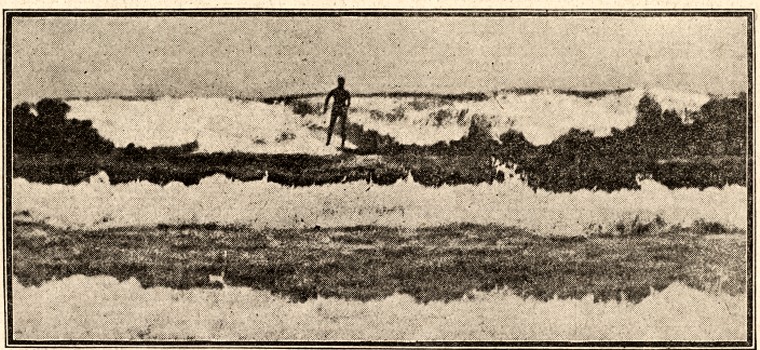 DUKE
KAHANAMOKU, THE HAWAIIAN SWIMMER,
RIDING THE
BREAKERS ON A BOARD AT FRESHWATER YESTERDAY.
DUKE
KAHANAMOKU, THE HAWAIIAN SWIMMER,
RIDING THE
BREAKERS ON A BOARD AT FRESHWATER YESTERDAY.
- Acrobatics
in the Surf, The
Daily Telegraph, Friday
25 th December 1914, page 7.
A
second photograph, published a week later by the Sunday Times ,
shows Duke "styling," obviously for the cameraman, in the shore
break.
A larger wave, like that ridden in the photograph
above, breaks outside .
This edition also included a photograph of
Duke carrying the board on his shoulder, the traditional
manner, with the rocky undeveloped south point of Freshwater
in the background.
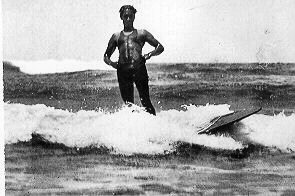 |
HIS EXHILARATING PASTIME OF SURF BOARDRIDING.
Duke
Kahanamouku, world's champion swimmer,
standing on his surf board shooting the breakers
at Freshwater.
-"Sunday Times," photo
- The
Wonderful Water Feats of Duke
Kahanamouku,
The Globe and Sunday
Times War Pictorial,
Sydney, Saturday 2
January 1915, page 3.
|
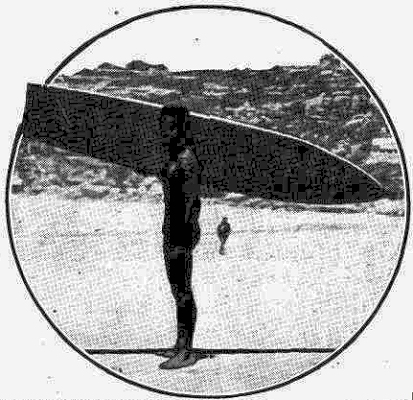
KAHANAMOUKU
CARRYING THE IMMENSE BOARD
ON WHICH HE CARRIES OUT HIS WONDERFUL WATER FEATS.
It measures 8ft 6in by 2ft.
is 3in through at its thickest part, and weighs over 70lb.
- The Wonderful
Water Feats of Duke Kahanamouku,
The Globe and Sunday Times
War Pictorial, Sydney, Saturday
2 January 1915, page 3.
A similar, and often printed (although usually undated) photograph of Duke
Kahanamoku carrying the board in the same manner, was
likely to be taken at the same time on the same day.
Note the absence of spectators, or any other
beach-goers, and the shadows indicating that
both were shot at around noon.
- Myers: Freshwater
LSC (1983) page 56. |
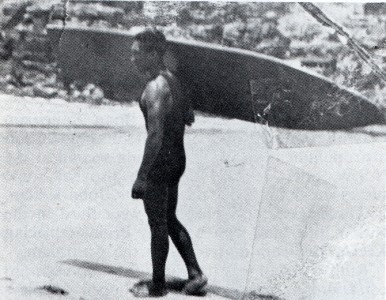 |
The
following day was Christmas and over the next four days Duke (and
his swimming companion, George Cunha) had few obligations apart
from preparing for their preliminary heats on 30 December 1914 at
the Domain Baths for the State Championships on Saturday 2nd
January 1915.
While Cunha won his heat at the trials, Duke Kahanamoku,"owing to a slight ear trouble, did not start," although there was an
improvement and he "would be able to enter the water,
perhaps today
(31st December)."
Nevertheless, he was seeded directly through to the final on Saturday.
- Sydney Morning
Herald, 31 December 1914, page 5.
The touring party may have attended a Schoolboy's
Carnival,at the Domain Baths on the28 December, where they
gave a sswimming
demonstration.
- Daily
Telegraph, 29 December 1914, p 3
The January swimming carnivals were an outstanding success,
with a packed house and on 6th, Kahanamoku set a new world
record for the 100 yards sprint
of 53 4/5 seconds.
- The
Referee, 6 January 1915, page 16.
The record was
reported world wide, including an article in the sports
section of the New York Times.
- New York
Times, 14 February 1915, Sports Section, page S3.
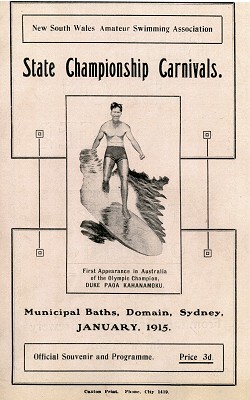 |
New
South Wales Amateur Swimming Association:
State
Championship Carnivals.
First Appearance in Australia of the Olympic
Champion
Duke
Paoa Kahanamoku.
Municipal
Baths, Domain, Sydney,
January 1915.
Official Souvenir and Programme.
Price 3d.
Caxton Print, Phone City 1419.
|
With the completion of two highly successful
swimming carnivals, Duke returned to Boomerang and on Sunday
10th January gave two exhibitions comprising both surfboard
riding and body surfing.
In the
morning he appeared at Freshwater and in the afternoon at
South Steyne, Manly.
Kahanamoku,
the Hawaiian swimmer visited Freshwater yesterday morning,
where he gave some fine displays of surf-shooting.
In the
afternoon be treated the thousands of spectators on the
South Steyne Beach to a highly interesting and clever
exhibition of board and ordinary surf-shooting.
- Kahanamoku
in the Surf, The Sun, 11th
January
1915, page 6
Note that the
dedication plate, Reg Harris, Manly
LSC (1961) page 66, and Nat Young, The
History of Surfing (1983) page 47, record the date as
"15 January 1915".
This is not
possible, on the 15th January the Hawai'ian party was
already in Brisbane preparing for a series of Queensland
swimming carnivals.
Duke Kahanamoku, the celebrated swimmer from
the Hawaiian Islands, and his swimming companion,
George Cunha, and the manager of the tour arrived in
Brisbane last night by the Sydney mail train.
- Swimming
- Duke Kahanamoku - Arrival in Brisbane, The Brisbane
Courier, Friday 15 January 1915, page 3.
A large number
of photographs were taken at the morning exhibition at
Freshwater.
Duke
Kahanamoku reception, Freshwater
Clubhouse, Sunday 10th
January 1915.
S. Mound, club captain with F insignia, standing next to Duke.
Forbes in Myers: Freshwater
LSC (1958,1983) page 17.
|
Left:
Duke Kahanamoku and surfboard, #1,
Freshwater
Club House,
Sunday 10th January 1915.
- Reference???
Right:
Duke Kahanamoku and surfboard, #2,
Freshwater
Club House,
Sunday 10th January 1915.
Thoms:Surfmovies
(2000) page 22.
Accredited:
23 December 1914, Snow
McAlister. |
|
|
|
Duke Kahanamoku leaving the surf,
Freshwater Beach,
Sunday
10th January 1915.
- Young: History
(1983) page 47
Accredited:
15 January 1915, Snow
McAlister.
Also printed in
- Hall and Ambrose: Memories
of Duke (1995) page 40.
Accredited:
December 1914, Courtesy Heather Rose.
Note that in addition to Duke
Kahanamoku's board, there are seven
other surf riding boards in this photograph.
Click the image for a detailed analysis.
|
Detail right from Curby-
find another copy without page join!
Duke Kahanamoku,
board carry apres surf, ,
Freshwater Beach, Sunday
10th January 1915.
Note the board's shadow on the sand .
|
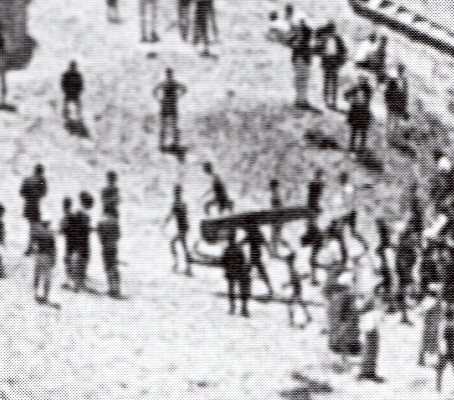
|
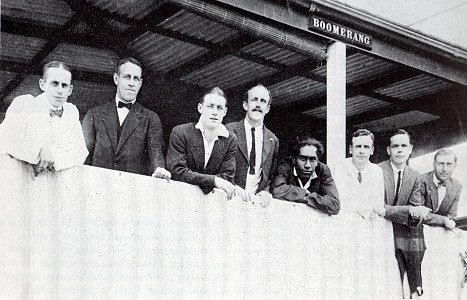
Duke, with Fred
Williams, first local bodysurfer
(moustache),
Harry Hay, Olympic swimmer
(to his right), Don
McIntyre, far left.
'Boomerang' camp,
Freshwater Beach, Sunday
10th January 1915.
-
Margan and Finney: Pictorial
History (1970) page 112.
Note Duke's swimsuit drying on rail, left.
|
Duke, Harry
Hay, Olympic swimmer, to his left.
Don
McIntyre, far left.
Boomerang
Camp,
Freshwater,
Sunday
10th January 1915.
Longhurst:
Lifesaver
(2000) page 16.
(accredited
as Cronulla).
|
This photograph of Duke
riding the board at Freshwater could have be taken on any
time before or after the exhibition of the 10th January.
Right:
Duke Kahanamoku surfboard
riding, Freshwater
Beach, December 1914 - January 1915.
|
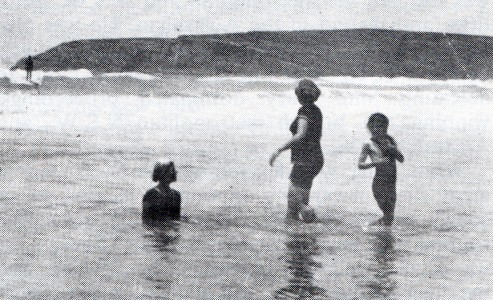 |
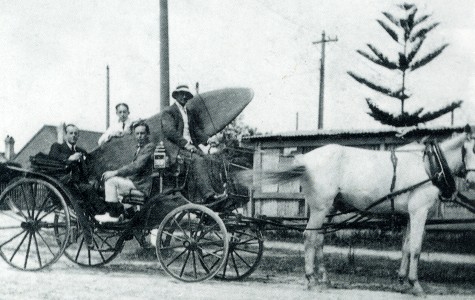
|
Another widely published photograph of the board shows it
in transit in the back of a horse-drawn carriage:
Duke Kahanamoku's board in
transit,
courtesy of The White Creamy Ponies,
circa January - February 1915.
- Warshaw:
Surfriders (1997) page 18;
- Kampion: Stoked
(1997) page 40.
|
The White Creamy Ponies was a "taxi" company
serving the Manly area, with a long association with the local
surf lifesaving movement.
At the parade preceding the Manly carnival in
1910:
The white creamy ponies and carriages of
Manly took up the van of the procession and were
occupied by
Mr F. W. J. Donovan (president), Mr A. W. Relph
(secretary) and the
committee of the club.
- Unaccredited:
Manly
Surf Carnival, Sydney
Morning Herald, Monday 21 March 1910, page 10.
The following
weeks he continued a program of swimming races and surfing
demonstrations at metropolitan beaches including Coogee,
Cronulla, Dee Why and other Northern beaches.
At Dee Why ... tandem, large crowd, ..
At Cronulla ... race in belt, picnic, ..
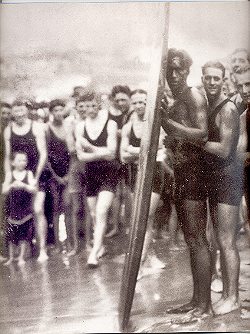 |

Above: Duke
Kahanamoku surfboard riding, Cronulla
6th February 1915.
Thoms:Surfmovies
(2000) page 22.
Left: Duke
Kahanamoku, surfboard and Cronulla
SLSC members,
Cronulla NSW 6th February 1915.
Warshaw
: Surfriders
(1997) page 16 [cropped].
|
One of the early Manly
boardriders, Basil Kirke, had a long career as a radio
presenter, and later an administator, in the Australian
Broadcasting Corporation (ABC).
In 1928 he gave his first radio broadcast of his "History
of Surf Bathing" on
Sydney radio, and after transfering to Perth, WA, in
1929?, he gave further broadcasts and similar
presentations at various WA surf lifesaving events,
often titled "'The History of Surf
Bathing in Australia."
- 2BL, Sydney, The Brisbane
Courier, 22 December 1928 , page 24.
- News and Notes,The West
Australian, Perth, 14 June1930, page 14.
- Broadcast
Programmes- 6WF, Mirror,
Perth, Saturday 18 October 1930, page 4.
In a trans-national
radio broadcast in 1931, in Perth, Kirke introduced Mr. C. D. Paterson,
then president of the New South Wans Surf Life Saving
Association, transmitting his greetings to the North Coltesloe
Surf Life Saving and Athletic Club from Manly, New South Wales,
via telephone.
- - Broadcast
Programmes- 6WF, The West
Australian, Perth, Monday 26 January 1931, page 6.
Patrica Gilmore's article, When Ironing Boards Took
To The Waves, published
in the Sydney Morning Herald in late
1947, was an early summary of the
history of surfboard riding in Sydney, that was
probably was the source for many subsequent
accounts.
She reported that:
The first surfboard
(was) imported to
Australia (by) Mr. C. D.
Patterson in 1912 from Honolulu, (a) nine-feet piece of
redwood, it ended in the Patterson household as an ironing
board!
(Thereafter) Jack Reynolds, Norman Roberts,
and "Looney" Walker were inspired to
make boards with Les Hynes (a builder at North Steyne).
In 1914, the
Australian Swimming Association decided to invite Duke
Kahanamoku to this country—as a swimmer.
While
here, he was asked to give an exhibition of surfboard riding.
Having no board, he picked out some sugar pine from George
Hudson's, and made one.
This board—which is now in the proud possession of Claude
West—was eight feet six inches long, and concave underneath.
It was in
February, 1915, that the Australian board enthusiasts had
their first opportunity of seeing a "board expert" on the
waves.
- Patrica Gilmore: When
Ironing
Boards Took To The Waves,
Sydney Morning Herald,
Saturday 29 November 1947, page 12.
Several of Patrica Gilmore's
inaccuracies were reproduced in C. Bede Maxwell's Surf - Australians Against the Sea,
published in 1949.
A hard-cover book, endorsed by the SLSA, its readership and its
impact was far more widespead.
In a chapter titled Surfboards and Surfskis, she wrote a
glowing account the surfboard
riding career of Manly's
Claude West, apparently based largely on West's
recollections:
West was to become the Hawaiian's (Kahanamoku's) star pupil.
By the time the kindly, generous instructor had left Australia,
Claude West had become the most proficient surf-rider on the
coast.
Annexing the Australian championship in the same year, 1915, he
successfully defended this until 1925, contemporaries swearing
that surely young West had suckers on his feet.
No wave seemed able to throw him.
- C.B.Maxwell: Surf
- Australians Against the Sea (1949), page 237.
Although not specifically stated in the
text, there is some implication that ????
West does not appear any contemporary reports of surfboard riding
preceding or during the Kahanamoku tour.
He is first
mentioned in print in February 1915, when he and (Freddie)
Williams rescued Neil Peter Nielson, 27, and Alfred Ferns, 10, from the North Steyne surf with
a line (and reel?); Neilson, however, did not recover
consciousness.
- Drowned
at Manly, The Sydney Morning
Herald , Wednesday 24 February 1915, page 12.
Furthermore, Claude West is not mentioned
in any of the reports of Sydney surfboard riders in Australia's
first serial surfing publication, The Surf, published
weekly during the summer of 1917-1918.
- The
Surf - A Journal of Sport and Pastime, Con. Drew, 1 December 1917 - 6 April 1918.
There was no "Australian (surfboard)
championship in 1915," all such references in the
literature are only retrospective, and are strictly incorrect.
There were a number of surfboard exhibitions or contests in the
years immediately following the Kahanamoku tour, often in
association with body and/or boat surf riding events at various
surf carnivals.
However, West is not listed as a place-getter in any of these
early events (provide a list of winners?), and his first victory was probably a surfboard "display" at North
Steyne at the end of 1919, five years after the Kahanamoku
exhibitions.
S. Dowling,
also representing the Manly Club, was in second place.
- North Steyne Carnival,
The Sydney Morning Herald, Monday
8 December 1919, page 8.
In researching her book, Maxwell obtained,
probably at her request, a brief paper, Notes on
surfboard riding,
by the then current President of the Surf Life Saving Association,
Adrian Curlewis.
In his Notes,
not included by Maxwell in her
book, Curlewis
he wrote that Kahanamoku’s Freshwater board was handed over to
George and Monty Walker of Manly, who:
because of the fine work Claude West had
done in popularising surfboard riding,
eventually gave it to Claude West, and he
still has it, a prized possession.
- Adrian
Curlewis: Notes on surfboard riding prepared by S.L.S.A.,
[circa 1948]
Papers
pertaining to C. Bede Maxwell’s Surf: Australians Against the
Sea, 1949.
Mitchell Library,
Sydney, ML MSS 196, page 3.
Adrian Curlewis received his first
lessons in surfboard riding from John Ralston
at Palm Beach
in the
early 1920s.
One of the
better Sydney beaches for boardriding, Ralston had introduced boards there in
1919.
Curlewis
then bought a used 70 lb
board for Ł5, advertised as:
Surfboard for sale.
Owner
in hospital through using same.
The seller
was Claude West, who had been
injured while transferring a patient from the board to a
surfboat.
Within several years, Curlewis became a "surfboard virtuoso."
-
Maxwell: Surf
(1949) , pages 238-239.
- Helen Frizell:
Judge Curlewis,The Australian Women's Weekly, Saturday 3 February 1951, page 17.
|
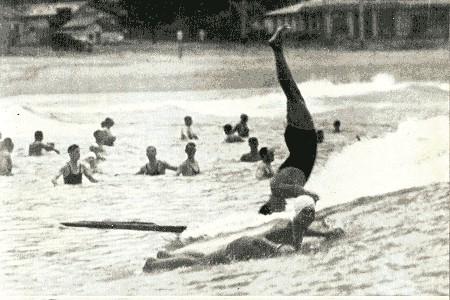
Adrian Curlewis headstand, Palm
Beach, circa 1929.
(Note that
the other boardrider, paddling out, is female.)
-
Maxwell: Surf
(1949) , facing page 208.
|
A founding
member of the Palm Beach Surf Life Saving Club, Curlewis was club
captain (1923-28) and president (1929-33), after which he was
president of the Surf Life Saving Association of Australia, except for a period military service in WW2, from 1934 to 1975.
- Douglas Booth, Curlewis, Sir Adrian
Herbert Frederic (1901–1985),
Australian Dictionary of Biography, National
Centre of Biography, Australian National University,
http://adb.anu.edu.au/biography/curlewis-sir-adrian-herbert-frederic-12382/text22253,
accessed 30 August 2013.
In further
trans-Pacific exchange of surfriding culture, Curlewis reported
that twenty years later:
The Walker Brothers sent a surf-ski to Duke
Kahanamoku at Honolulu and the members of the Australian
Pacific Games
team which
visited Honolulu in 1939 say Duke was often to be seen
paddling around on his 'ski from Australia'.
- Op. cit.,, pages 3 and 4.
Presumably the
board was in the possession of the Walkers at least until the
early 1920s, when his West's reputation was
firmly established, and was most probably handed over with his
retirement from competitive boardriding, circa 1925.
There were several Walker's amoungst Australia's earliest surfboard
enthusiasts, their familiar relationships somewhat confusing.
The best was Tommy
Walker, who returned fom Waikiki circa 1910 with a 10ft
surfboard, and surfed, and gave demonstrations, at Manly, Freshwater,
and on the north coast, at Yamba.
- [Harry Hay]:Tommy
Walker says "I Brought First Surfboard To Australia",
The Referee, 23 February 1939, page 16.
- Freshwater
Carnival, Daily Telegraph,
27 January 1912, page 21.
- Yamba Surf Life Saving Brigade, Clarence
and
Richmond Examiner,
Grafton,
5 January 1915, page 7.
Patrica
Gilmore's article, When Ironing Boards Took
To The Waves, published
in the Sydney Morning Herald in late
1947, outlined the history of
surfboardriding in Sydney that appears to be the
source for many subsequent accounts.
- Patrica Gilmore: When
Ironing
Boards Took To The Waves,
Sydney Morning Herald,
Saturday 29 November 1947, page 12.
Thc.ede 5 January rr1915, page 7.
C. Bede Maxwell reported that C.D.
Paterson, a member of the North
Steyne club, acquired a "real"
Hawaiian surfboard
in 1912, and lists a number of locals who attempted to ride
the board, beginning with "the
Walker Brothers."
- Maxwell: Surf
(1949) , page 235.
Several pages later, she further confirmed their
pre-eminence:
Manly has always been a
boardman's beach since the Walkers and Claude West first
became prominent in the game.
- Maxwell: Surf
(1949) , page 241.
Harald Baker, journalist and
"noted swimmer, surfer, and lifesaver," assessed
the skills of the Manly surfboard riders in mid-1914:
They ride with almost Hawaiian deptness,
particularly young Walker who is quite the "surf board king."
- Reg "Snowy" Baker: General
Physical Culture (1910), page 53.
- Harald Baker: Surfing, Evening News, Sydney, Saturday 11 April 1914, page 10.
Claude West was prominant
performer in surfboard events from 1919 to 1924-1925.
It is unclear if West rode Duke's board
in these events, indeed for this period it may have not
been in his possession.
It was certainly not the board that injured him in the
early 1920s, and was then sold to Adrian Curlewis.
In a photograph from the period (circa 1926) he is shown
holding a board, painted white
with a surf-reel logo and dark pinelines.
It is possible that this is Duke's board, under a heavy
coat of paint.
- Thoms: Surfmovies
(2000) page 23.
In 1952-1953 Claude West donated the board to the
Freshwater Surf Lifesaving Club.
At this time it is possible that he refurbished the
board, adding four metal
letters, perhaps somewhat unsuitable for use in the
surf, white pin-lines, and a white nose patch with an
extra truncated dark pin-line.
Alternatively, it is just as likely that the decor was
added only immediately before the expected return of Duke
Kahanamoku to Freshwater on his visit to Australia with
the visiting US/Hawaiian Olympic Surf Team in 1956.
|
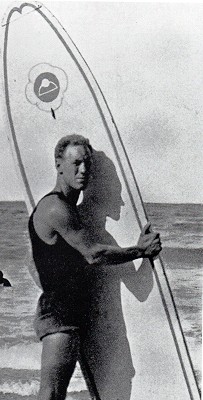
|
The
additions are evident in several photographs taken at Freshwater
in 1956.
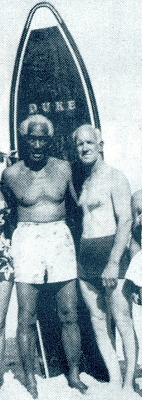 |
Left:
Duke Kahanamoku, Claude West and their board.
Freshwater
Beach,
1956.
Forbes in Myers: Freshwater
SLSC (1983) page 18, cropped.
Right:
Claude West and board,
Freshwater
Beach,
circa 1956.
- Manly Daily, May 1980.
-courtesy Eric Middledorp,Freshwater
SLSC.
|
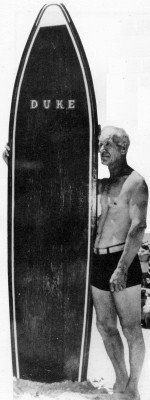
|
Freshwater SLSC club member, Joe Larkin,
recalled that in his youth:
During the early 1950's the board was
stored amoungst the current boards, given no special
prominance
and on
occassion was used by Club members, including myself.
- Joe Larkin,
noted in a phone conversation, February 2004, with many thanks.
Sometime
in the mid-1950s it had become the practice to inscribe the
names of the annual club champions, effectively making
it a "trophy board."
Several club members objected to this and the names were
removed, and on 15 November 1956, the Freshwater club
arranged for a bronze/chrome plate, detailing the board's
provinence, to be affixed below the metal letters.
- Eric
Middledorp, phone conversation, 2013.
Over the next
twenty years the board was a regular feature at
surfriding contests and special events.
In 1957-1958 Claude West was filmed riding the board on
"small waves at Manly Beach (featured) in Bud Browne's
film Surf Down Under (1958).
- Warshaw: Encyclopedia
(2004) page 690.
In November 1963, Duke
again travelled to Australia for the
launch of Jack Pollard's The
Australian Surfrider - The Complete
Book on Board and Body Surfing.
A compilation of articles covering
surfboards, body surfing, surfskis and
surfboats, Duke contributed a brief
foreward to the book under the
subtitle "first man to ride a
surfboard in Australia."
In the text, he slightly modififed that claim to "I had
the honour of making the first demonstration of surfboard riding in
Australia."
- Pollard: The
Australian Surfrider (1963)
page 7.
Neither claim is strictly
correct.
In December 1965, a third impression was
published, retitled The Surfrider - The
Complete Book on Board and
Body Surfing,
and the colour cover photograph of Dee Why
Point was replaced with one of Sunset
Beach, Oahu.
Duke wrote that:
When I left Australia
back in 1915 I gave my board to a chap who seemed to be the most
promising of the local riders.
This was Claude West, who later won a whole stack of Australian
surfriding championships.
I met Claude again, too, in
1963, when I saw my old board at Freshwater Surf Club, to whom
Claude had donated it in memory of my first ride.
- Pollard: The
Surfrider
(1965) page 7.
While the reunion with Isabel Letham and Claude West in 1963,
coinciding with the launch of the book, is recalled, their well
documented reunion in 1956 is not.
The recollection that "I gave my board to the most promising of the local
riders ... Claude West"
was, no doubt, substantially modified by
time and and circumstance, not the least
being Maxwell's account in her influential Surf (1949).
West certainly was a talented surfboard rider, had the board in
his possession for forty years, and in donating it to the
Freshwater SLSC he firmly established his connection to the board.
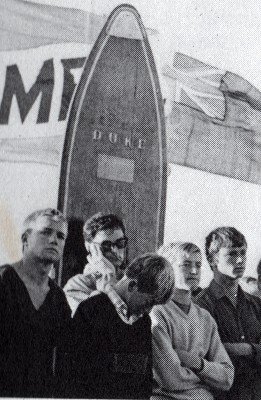
|
Left:
Duke's board with Peter Drouyn, Richard Kavanagh,
Russell Hughes,Ted Spencer,
Australian Titles, Coolangatta, 1966.
-
Margan and Finney: Pictorial History
(1970), page 169.
This image shows the board with the metal
plate affixed.
Right:
Claude West, Freshwater, 1975.
- Manly Daily, 1975.
- courtesy Eric Middledorp, Freshwater SLSC.
Note that the white nose
patch with extra truncated
pinline appears to be removed.
|
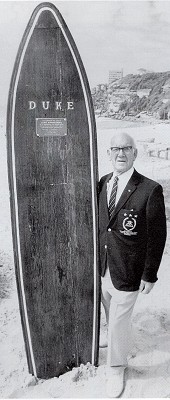
|
|
In an extensive article on the board
published in 1996, Sandra Kimberly Hall, apparently
based on the recollections
of Claude
West's family, wrote
that the board:
fell off a truck in 1975, and
split down the middle, and was run over.
The elderly (Claude) West
restored it expertly.
-
Sandra Kimberly Hall: The Million Dollar
Surfboard, Longboard, April-May 1996,
page 74.
Said
to be returning from a contest in Queensland,
Hall does not note that at the time the board
was in West's care, on loan from Freshwater, and
he was ultimately responsible for the damage.
The
"expert restoration" was probably
carried out behind closed doors, and out of
sight of club officals.
It
was at this point that the three lateral steel bolts,
found that inside the board in a major refurbishment
in 2011-2012, were most likely installed, shown
below.
Following these major repairs the white nose patch with extra
truncated pinline appears to have beeen removed,
while the metal letters and the
dedication plate were re-affixed.
Right: Snowy McAlister and Claude
West, Freshwater SLCS, circa 1978.
Photograph by Bill McCausland.
Young: Book of Surfing (1979) page 71,
|
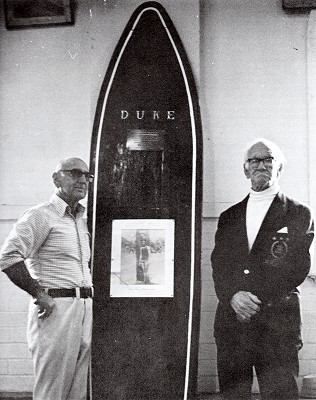
|
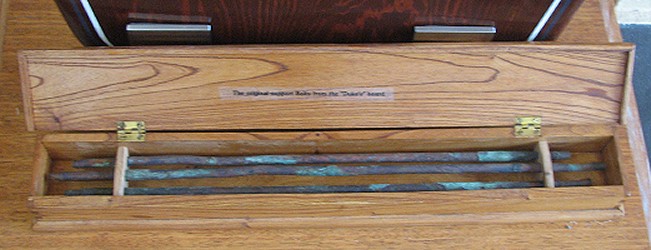
In 1980, ithe board was present at
Claude West's furneral, and it appeared in 1988 in
the Hawaiian Pavillion at Brisbane's World Fair.
- Sandra Kimberly Hall: The
Million Dollar Surfboard, Longboard,
April-May 1996, page 74.
Isabel Letham's contribution
was recognised when she was made a life
member and the patron of the Australian
Womens Board Riders Association in 1978, and
in 1983 she was photographed with a contigent
of the then current professional women
surfers at Freshwater.
In this photograph, the metal plate is
absent, possibly the result of another "refurnishment."
-
Warringah Library: Making Waves- Isabel Letham
1899-1995 [1995], pages 19 and 21.
The photograph of the board with Isabel
Letham and Snowy McAlister, (Freshwater, 1983-4), right,
was possibly taken on the same day.
- image courtesy Eric Middledorp., Freshwater SLSC.
|
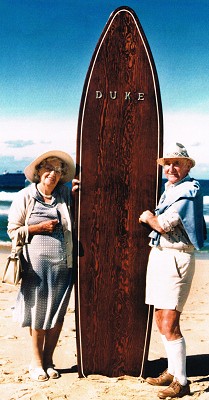 |
Over the
following decades the board probably had several
restorations or refurbishments.
In
photographs of the board at its appearance at
significant events and contests over these years, the
dedication plate has disappeared and returned in various postions.
Currently
exhibited in the Heritage Room, Freshwater Surf Life Saving
Club, The Esplanade, Harbord NSW, ph : 02 9905 3741.
Duke Kahanamoku's Other Australian Boards
Several three, if not more, other surfboards were shaped by
Duke Kahanamoku while in Australia, these possibly donated to
raise donations to the war effort.
One board was presented to the
Surf Bathing Association of New South Wales and subsequently
became the property of a Cronulla Club member, Ron 'Prawn' Bowden.
The history of
the other two is currently unknown, however one may have been
the board used by "Sprint" Walker when he introduced (standup)
surfriding to Victoria at Portsea in 1926.
This board itself
had four copies made while in Victoria.
His design would
be replicated for the next 25 years.
(See Plans and
Specifications : Alaia, 1938).
Returning to
Hawaii Kahanamoku left the board, and a great amount of
surf knowledge, initially with the Walker brothers, who later
passed the board on to Claude West.
West is first mentioned in the Sydney press
in performing a rescue at North Steyne with
[Freddie] Williams in 1915.
- Drowned at Manly,
Sydney Morning Herald,
Wednesday 24 February 1915, page 12.
Claude West rode the board, dominating
surfboard competitions in the period 1922? to 1928, and was later
recognised as the first Australian Board Champion.
In 1953 Claude
West donated the board to the Freshwater Surf Lifesaving Club.
After leaving Australia in 1915 Duke
Kahanamoku gave further exhibitions in New Zealand, on another
"makeshift" board.
COMMENTS
Previously, the
board was mounted in a tight fitting timber sided and glass
topped case in the Club Room, which made examination of the
board difficult.
The current
exhibition is a significant improvement.
The board
photographs were taken on the 23rd November 2012 on the
occassion of the release of Phi Jarratt's excellent Surfing Australia, when the board was relocated to the beach
front for photographs with the invited guests.
The occasion also
celebrated 50 years of Surfing Australia, with the release of a
special coin by the Australian Mint and the announcement of the
release in 2013 of four surfing stamps by Australia Post.
The guest of
honor was acting Australian Prime Minister, Wayne Swan and the
master of ceremonies Channel 10 weather reporter, Tim Bailey.
Other guests
included Phil Jarrett and Norm Innis, Chairman of Surfing
Australia.
Notable surfers
included Mark Richards, Terry Fitzgerald, Mark Warren, Barton
Lynch, Nick Carroll, Tom Carroll, and Layne Beachley.
Many thanks to
the Freshwater Surf Life Saving Club, the board's curator, Eric
Middledorp, Tim Baker, and Nick Carroll.
DESIGN HISTORY


surfresearch.com.au
Geoff Cater (1998-2014) : #100 Duke
Kahanamoku Sugar Pine, 8ft 6'', 1914.
http://www.surfresearch.com.au/00000100.html
In
November 1963, Duke again travelled to Australia
for the launch of Jack Pollard's The
Australian Surfrider - The Complete Book on
Board and Body Surfing.
A compilation of articles covering surfboards,
body surfing, surfskis and surfboats, Duke
contributed a brief foreward under
the subtitle "first man to ride a surfboard in
Australia."
In the text, he slightly modififed that
claim to "I had the honour of making the first demonstration
of surfboard
riding in Australia."
- Pollard: The Austrailian
Surfrider (1963) page 7.
Neither claim is strictly correct.
In December 1965, a Third Impression
was published, retitled The
Surfrider - The
Complete Book on Board
and Body Surfing,
and the cover photograph of Dee Why
Point was replaced with one of Sunset
Beach, Oahu.
Duke wrote, although the piece was probably
"polished," that:
"My memories of Australia go back to
1915 when I was world freestyle champion and gave the first
demonstration of surfboard riding in Australia.
A few Australian surfers had tried the boards but they hadn't
got the knack, so I pencilled out a design and asked George
Hudson's timber yard to make up a board for me.
I finished off the board by hand myself and at Freshwater
Beach on Sydney's northside, showed Australians for the first
time how it was done.
There was a tiny little girl in the crowd that day who by her
manner seemed more excited than all in the crowd.
I put her up on my shoulders and we made a few good rides.
In 1963, we met again — Isobel Latham, now of course, a mature
adult.
When I left Australia back in 1915 I gave my board to a chap
who seemed to be the most promising of the local riders.
This was Claude West, who later won a whole stack of
Australian surfriding championships.
I met Claude again, too, in 1963,
when I saw my old board at Freshwater Surf Club, to whom
Claude had donated it in memory of my first ride."
- Pollard: The Surfrider (1965) page
7.
The account
notes the
presence of
surfboard riders
in Australia
before 1914, and
confirms that
the template,
from his "pencilled
out design,"
was cut out at
by a carpenter
at Hudson's
before he "finished off the board by hand."
While the reunion with Isabel Letham and Claude West in 1963,
coinciding with the launch of the book, is recalled, their
well documented reunion in 1956 is not.
These recollections
are probably modified by time and and
circumstance, for example the claim
that "I gave my board to the most promising of the
local riders ... Claude West."
West certainly was a talented surfboard rider, had the board
for a long time, and in donating it to the Freshwater SLSC he
firmly established his connection to the board.
The account notes the
presence of
surfboardriders
in Australia
before 1914, and
confirms that
the template,
from his "pencilled
out design,"
was cut out at
by a carpenter
at Hudson's
before he "finished off the board by hand."
While the reunion with Isabel Letham and Claude West in 1963,
coinciding with the launch of the book, is recalled, their
well documented reunion in 1956 is not.
These recollections
are probably modified by time and and
circumstance, for example the claim
that "I gave my board to the most promising of the
local riders ... Claude West."
West certainly was a talented surfboard rider, had the board
for a long time, and in donating it to the Freshwater SLSC he
firmly established his connection to the board.












